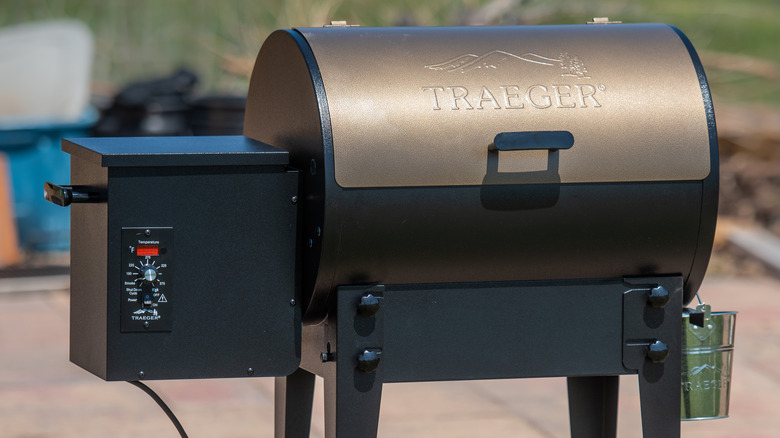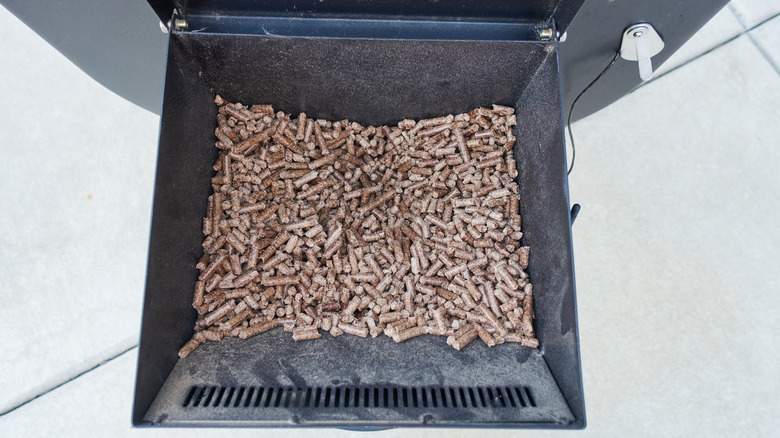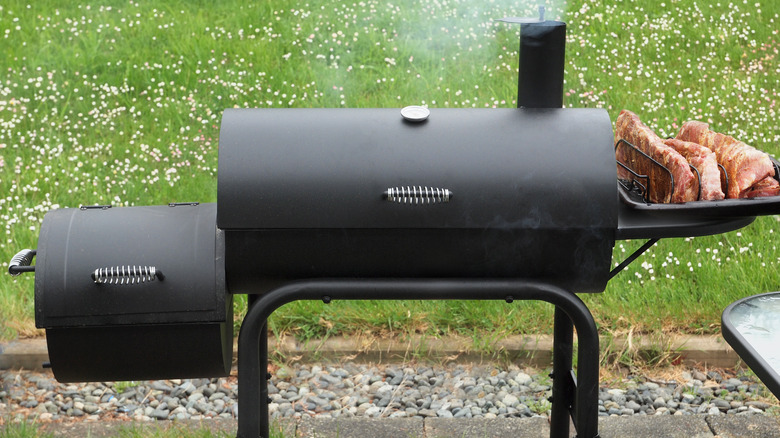What Separates A Pellet Grill From A Smoker?
Backyard barbecue enthusiasts, meat lovers, and smoke seekers know that there's nothing like food cooked over smoldering wood. There are lots of different devices to get that crave-worthy taste, and while a regular backyard grill or traditional smoker won't do you wrong, pellet grills stand apart because of their unique heating system, diversity of functions, and power source. While a pellet grill can act as a smoker, it can also be used like a regular grill and even an oven.
On the other hand, there's a different device called a pellet smoker, which can really only be used for slow-cooking at low heat. Confusingly, the names of these tools are sometimes used interchangeably, because they both use pellets and rely on the same mechanics, though their ranges of use differ.
Pellet grills and pellet smokers are both electric. Once these devices are plugged into an outlet, pellets are loaded into a chamber called a hopper, and then ignited by flipping a switch or pressing a button. The internal auger moves the pellets from the hopper to the fire pot where they are lit; however, there is no open flame inside. Once you set the temperature using a dial or digital meter, a fan disperses smoke and heat throughout, creating a sort of convection oven effect. Some models can even be controlled through an app on your phone. When considering which device to buy, it helps to think of what you cook the most often.
Cooking with pellet grills and pellet smokers
You can cook low-and-slow with both a pellet smoker and pellet grill; both devices usually have a minimum temperature of 150 degrees Fahrenheit. You can amp up the machines to 225 to 275 degrees Fahrenheit to smoke items like a slab of brisket, whole chickens, pork shoulder, a side of hot smoked salmon, or even smoked and braised short ribs. However, that's where a pellet smoker's functionality ends.
On the other hand, the range of settings on the pellet grill makes it multi-functional. Most models can be cranked up to about 500 degrees Fahrenheit, which means quick-cooking hot dogs, burgers, sticky-sweet chicken skewers, whole roasted cauliflower, or a perfect grilled skirt steak can get a good sear and come out deliciously browned.
One similarity is that you can use the same kinds of pellets in either machine. These are made of compressed bits of hardwood from scrap lumber, wood chips, and sawdust. Treat the pellets as an ingredient that provides depth of flavor. For example, the best types of wood to use for smoking brisket are rich and intense, like post oak or mesquite, while something like chicken or pork may benefit from a lighter and sweeter flavor from woods like cherry, apple, or pecan. Just make sure to get the pellets that are food-grade and meant specifically for cooking, not heating.
Pellet smokers versus traditional smokers
There are many different types of smokers beyond pellet smokers. Offset smokers are perhaps the most recognizable and more widely associated with professional barbecue. These have a big, heavy, cylindrical barrel; a firebox off to the side; and a chimney for air flow. Wooden logs or charcoal topped with wood chips are lit in the firebox, and that smoke and heat is drawn into the main barrel.
The fuel source must be tended to create the right amount of quality smoke. If the temperature isn't in the right range, you must adjust it by adding or removing wood, or introducing water. This is good for someone with know-how, because you can tweak the inputs to get your exact desired result, but can be challenging for a beginner. Some connoisseurs also say the smoke flavor from offset smokers is more desirable.
The major draw of pellet smokers is that temperature regulation is totally automated. You don't have to do anything but load in the pellets and set the temperature, and they can heat up in about 15 minutes, while an offset smoker can take around an hour. You can purchase a small pellet smoker for about $500, but most will cost you $2,000 to $3,000 or more. A good quality offset smoker will be similarly priced, though. If you value ease, a pellet smoker may be preferred, but an offset smoker would be better if you're interested in learning all the ins and outs of barbecue.



